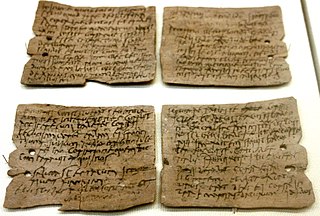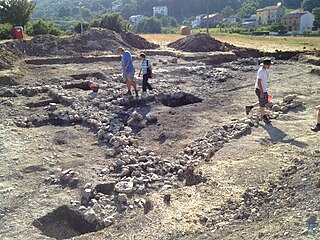Related Research Articles

Vindolanda was a Roman auxiliary fort (castrum) just south of Hadrian's Wall in northern England, which it pre-dated. Archaeological excavations of the site show it was under Roman occupation from roughly 85 AD to 370 AD. Located near the modern village of Bardon Mill in Northumberland, it guarded the Stanegate, the Roman road from the River Tyne to the Solway Firth. It is noted for the Vindolanda tablets, a set of wooden leaf-tablets that were, at the time of their discovery, the oldest surviving handwritten documents in Britain.
Below are notable events in archaeology that occurred in 1926.
The year 1973 in archaeology involved some significant events.
Below are notable events in archaeology that occurred in 1898.
The year 1972 in archaeology involved some significant events.
Below are notable events in archaeology that occurred in 1906.
The year 1958 in archaeology involved some significant events.
The year 1954 in archaeology involved some significant events.
Below are notable events in archaeology that occurred in 1936.
Below are notable events in archaeology that occurred in 1935.

Ernest Nash was a student of Roman architecture and pioneer of archaeological photography. Nash was born as Ernst Nathan in Potsdam, Germany, but later changed his name to Nash when he was living in the United States between 1939 and 1952.
The year 1955 in archaeology involved some significant events.
Below are notable events in archaeology that occurred in 1950.

Eric Barff Birley,, was a British historian and archaeologist, particularly associated with the excavation of the forts of Hadrian's Wall, notably at Vindolanda.

The Vindolanda tablets were, at the time of their discovery, the oldest surviving handwritten documents in Britain. They are a rich source of information about life on the northern frontier of Roman Britain. Written on fragments of thin, postcard-sized wooden leaf-tablets with carbon-based ink, the tablets date to the 1st and 2nd centuries AD. Although similar records on papyrus were known from elsewhere in the Roman Empire, wooden tablets with ink text had not been recovered until 1973, when archaeologist Robin Birley, his attention being drawn by student excavator Keith Liddell, discovered some at the site of Vindolanda, a Roman fort in northern England.
Robin Edgar Birley was a British archaeologist. He was the Director of Excavations at the Roman site of Vindolanda and head of the Vindolanda research committee. He was the son of Eric Birley and brother of Anthony Birley. His wife Patricia Birley and son Andrew Birley are also published authors on Roman Vindolanda.

Andrew Robin Birley is a British archaeologist and the Director of Excavations on the site of Vindolanda. He is the son of Robin Birley and grandson of Eric Birley, who founded the department of Archaeology at Durham University. He graduated from the University of Leicester in the summer of 1996 and has been working on the site for 18 years, ten of which have been in full-time employment by the Vindolanda Trust.
Daimabad is a deserted village and archaeological site on the left bank of the Pravara River, a tributary of the Godavari River in Shrirampur taluka in Ahmednagar district of Maharashtra state in India. This site was discovered by B. P. Bopardikar in 1958. It has been excavated three times so far by the Archaeological Survey of India teams. The first excavation in 1958-59 was carried out under the direction of M. N. Deshpande. The second excavation in 1974-75 was led by S. R. Rao. Finally, the excavations between 1975-76 and 1978-79 were carried out under the direction of S. A. Sali. Discoveries at Daimabad suggest that Late Harappan culture extended into the Deccan Plateau in India. Daimabad is famous for the recovery of many bronze goods, some of which were influenced by the Harappan culture.

The Sangro Valley Project is an Anglo-American ongoing archaeological excavation in Abruzzo, Italy. It is notable for its revolutionary interpretation of Samnium as a dynamic participant in the history of the Adriatic as well as its early adoption of modern excavation technologies, such as GIS. The project currently managed by Oberlin College in collaboration with Oxford University, Durham University and the Soprintendenza per i Beni Archeologici dell'Abruzzo, is a multi-disciplinary team of specialists from Canada, Italy, the United Kingdom, and the United States.
The year 2014 in archaeology involved some significant events.
References
- ↑ BAXŞƏLİYEV, VƏLİ (2007). AZƏRBAYCAN ARXEOLOGİYASI (PDF). Elm. Archived from the original (PDF) on 2020-01-11. Retrieved 2020-06-28.
- ↑ Rosenberg, Jennifer. "1974 - Terracotta Army Discovered in China". About.com. Archived from the original on 2011-10-20. Retrieved 2011-11-03.
- ↑ Johanson, Donald; Edey, Maitland A. (1981). Lucy, the Beginnings of Humankind. St Albans: Granada. ISBN 0-586-08437-1.
- ↑ "Andrew Birley". British Film Institute. Retrieved 5 June 2017.
- ↑ Radnoti-Alföldi, M.; Lahusen, M. C. (2000). Ernest Nash - Ernst Nathan: Potsdam, Rom, New York, Rom. Nicolai'sche Verlagsbuchhandlung. ISBN 3-87584-045-3.